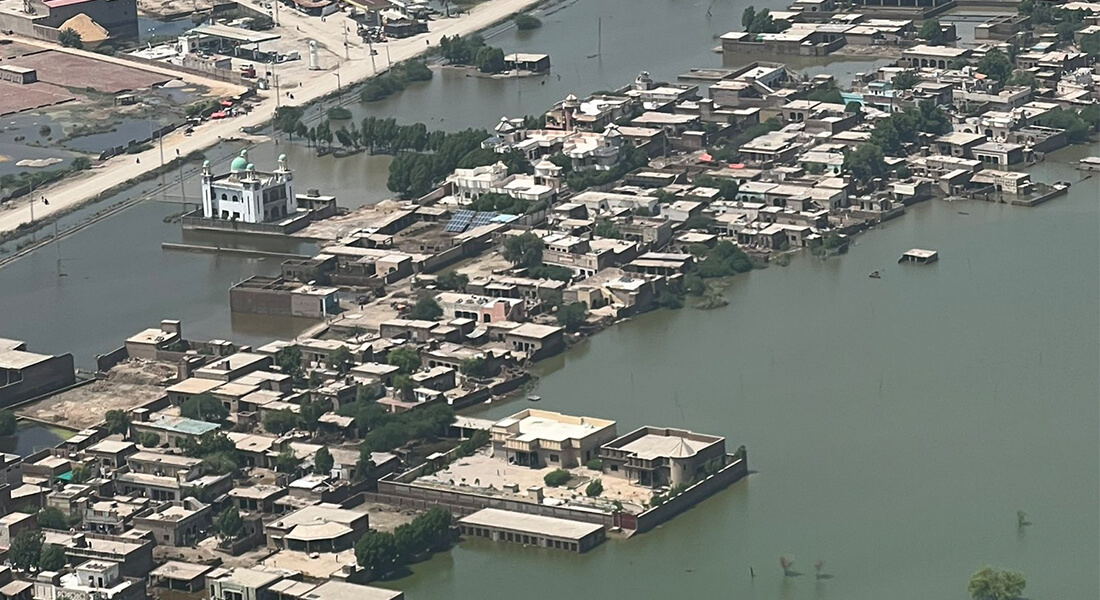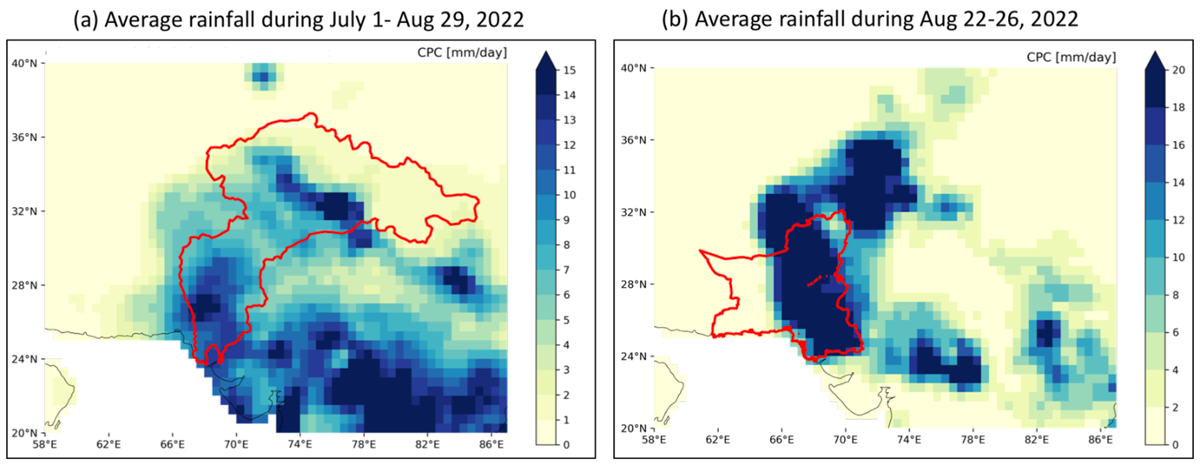Climate change likely increased extreme monsoon rainfall, flooding highly vulnerable communities in Pakistan
From mid-June until the end of August 2022, large parts of Pakistan experienced record-breaking monsoonal rainfall, leading to large parts of the country being flooded.

Pakistan is reported to have received more than 3 times its usual rainfall in August, making it the wettest August since 1961. The two southern provinces, Sindh and Balochistan, each experienced their wettest August ever recorded, receiving 7 and 8 times their usual monthly totals. The Indus river, that runs the length of the country, burst its banks across thousands of square kilometres, while the intense rainfall also led to urban flash floods, landslides.
The rains and resulting flooding affected over 33 million people, destroyed 1.7 million homes, and nearly 1500 people lost their lives (NDMA, 2022; VOA News, 2022). On August 25th, the government declared a national emergency. Damages likely exceed preliminary estimates of around US$30 billion with further economic disruption certain in the months to come (Business Standard, 2022), as around 6700 kilometres of road, 269 bridges and 1460 health facilities were destroyed (OCHA, 2022), 18590 schools damaged (Save the Children, 2022), approximately 750 thousand livestock were killed (NDMA, 2022) and around 18,000 square kilometres of cropland were ruined, including roughly 45% of the cotton crop – one of the nation’s key exports. The loss of food crops totalling around US$2.3 bn also compounds the ongoing food shortages due to the war in Ukraine and summer heatwaves in the region. There is also a severely heightened risk of the spread of disease, as stagnant flood waters provide a breeding ground for pathogens, and the vast number of people displaced results in poor hygiene and sanitation in temporary accommodation (Sarkar, 2022; Baqir et al., 2012). Notably, across Sindh and Balochistan, there has been an outbreak in waterborne disease such as diarrhoea and cholera, as well as skin and eye infections, and malaria (IRC, 2022).
To analyse whether and to what extent human-caused climate change altered the likelihood and intensity of this extreme rainfall, scientists from Pakistan, India, the Netherlands, France, Denmark, South Africa, New Zealand, the US and the UK used published, peer-reviewed methods to perform an event attribution study, focussing on two aspects of the event: (1) The annual maximum of the mean 60-day precipitation during June-September over the Indus river basin (Figure 1 (a)), and (2) the annual maximum of the mean 5-day precipitation in June-September over the worst hit provinces Sindh and Balochistan (Figure 1 (b)).

Main findings
- The flooding occurred as a direct consequence of the extreme monsoon rainfall throughout the summer 2022 season exacerbated by shorter spikes of very heavy rain particularly in August hitting the provinces Sindh and Balochistan. We therefore consider 60-day and 5-day maximum rainfall during the monsoon season for the Indus basin and the two provinces respectively.
- The devastating impacts were also driven by the proximity of human settlements, infrastructure (homes, buildings, bridges), and agricultural land to flood plains, inadequate infrastructure, limited ex-ante risk reduction capacity, an outdated river management system, underlying vulnerabilities driven by high poverty rates and socioeconomic factors (e.g. gender, age, income, and education), and ongoing political and economic instability.
- The return time for both events defined above is about 1 in 100 years in today’s climate. Rainfall in the Indus basin is however extremely variable from year to year, due to, amongst other drivers, the strong correlation with the ENSO cycle. Thus, exact quantification is difficult.
- First, looking just at the trends in the observations, we found that the 5-day maximum rainfall over the provinces Sindh and Balochistan is now about 75% more intense than it would have been had the climate not warmed by 1.2C, whereas the 60-day rain across the basin is now about 50% more intense, meaning rainfall this heavy is now more likely to happen. There are large uncertainties in these estimates due to the high variability in rainfall in the region, and observed changes can have a variety of drivers, including, but not limited to, climate change.
- Secondly, to determine the role of human-induced climate change in these observed changes we looked at the trends in climate models with and without the human-induced increases in greenhouse gases. The regions involved are at the western extreme end of the monsoon region, with large differences in rainfall characteristics between dry western and wet eastern areas.
- Many of the available state-of-the-art climate models struggle to simulate these rainfall characteristics. Those that pass our evaluation test generally show a much smaller change in likelihood and intensity of extreme rainfall than the trend we found in the observations. This discrepancy suggests that long-term variability, or processes that our evaluation may not capture, can play an important role, rendering it infeasible to quantify the overall role of human-induced climate change.
- However, for the 5-day rainfall extreme, the majority of models and observations we have analysed show that intense rainfall has become heavier as Pakistan has warmed. Some of these models suggest climate change could have increased the rainfall intensity up to 50% for the 5-day event definition.
- Looking at the future, for a climate 2 °C warmer than in preindustrial times, models suggest that rainfall intensity will significantly increase further, for the 5-day event, while the uncertainty remains very large for the 60-day monsoon rainfall.
- Our results are in alignment with recent IPCC reports.
- Both current conditions and the potential further increase in extreme peaks in rainfall over Pakistan in light of anthropogencilimate change, suggest that there is an urgent need to reduce vulnerability to extreme weather in Pakistan.
Full StudyDownload the full study: Climate change likely increased extreme monsoon rainfall, flooding highly vulnerable communities in Pakistan, pdf (36 pages, 4.3 MB) |
